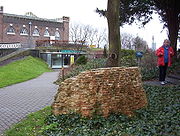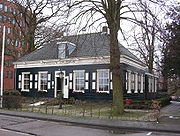
Museum De Cruquius
Encyclopedia




Pumping station
Pumping stations are facilities including pumps and equipment for pumping fluids from one place to another. They are used for a variety of infrastructure systems, such as the supply of water to canals, the drainage of low-lying land, and the removal of sewage to processing sites.A pumping station...
in Cruquius
Cruquius (town)
Cruquius is a town in the Dutch province of North Holland. It is a part of the municipality of Haarlemmermeer, and lies about 4 km northwest of Hoofddorp....
, The Netherlands. It derives its name from Nicolaas Kruik
Nicolaas Kruik
Nicolaas Kruik , also known as Nicolaes Krukius or most commonly by the Latinized Nicolaus Samuelis Cruquius, was a Dutch land surveyor, cartographer, astronomer and weatherman...
(1678–1754), a Dutch land-surveyor and one of many promotors of a plan to pump the Haarlemmermeer
Haarlemmermeer
Haarlemmermeer is a municipality in the Netherlands, in the province of North Holland. It is a polder, consisting of land reclaimed from water, and the name Haarlemmermeer means Haarlem's Lake, still referring to the body of water from which the region was reclaimed in the 19th century.Its main...
(Haarlem lake) dry. Like many well-educated men of his time, he latin
Latin
Latin is an Italic language originally spoken in Latium and Ancient Rome. It, along with most European languages, is a descendant of the ancient Proto-Indo-European language. Although it is considered a dead language, a number of scholars and members of the Christian clergy speak it fluently, and...
ized his name to Nicolaus Samuel Cruquius. During his lifetime the issue of the Haarlem Lake and how to pump it dry was international news, as the following excerpt from the Virginia Gazette on 31 May 1751 illustrates:
- "By a private letter from Rotterdam, we are told, that the Dutch Engineers, in their Plan for draining the lake of Haerlem, proposed to employ 150 mills for three Years, and had computed the Expence at a Million and Half of Florins, but that a German, who had been long employed in the Mines of Hungary and Hartz, had proposed to drain it with 50 machines, in 15 months, at a far less Expence; and that he has been ordered to erect one of those Machines, which, if it shall be found to execute what he has asserted, his Proposal will be immediately accepted."
Even 50 machines proved too expensive, so it was not until successful experiments with steam
Steam engine
A steam engine is a heat engine that performs mechanical work using steam as its working fluid.Steam engines are external combustion engines, where the working fluid is separate from the combustion products. Non-combustion heat sources such as solar power, nuclear power or geothermal energy may be...
pumping stations, such as at nearby Groenendaal park
Groenendaal Park
Groenendaal park lies at the center of Heemstede, Netherlands.The park includes the grounds of old Heemstede country estates Bosbeek, and Meer en Berg. Along its western borders are the old Heemstede country estates Hartekamp, Huis te Manpad, and Iepenrode. On the eastern boundary is the city...
in 1781, that serious plans resulted in three steam-driven pumping stations, including the one at Cruquius
Cruquius (town)
Cruquius is a town in the Dutch province of North Holland. It is a part of the municipality of Haarlemmermeer, and lies about 4 km northwest of Hoofddorp....
. As a tribute to former planners, the pumping stations of the Haarlemmermeer were named after them. The one at the mouth of the Spaarne
Spaarne
The Spaarne is a river, in North Holland, Netherlands. This partially canalized river connects the Ringvaart to a side branch of the North Sea Canal. It runs through Haarlem, Heemstede, and Spaarndam....
river, near Heemstede
Heemstede
Heemstede is a municipality and a town in the Netherlands, in the province of North Holland.-History :Heemstede formed around the Castle Heemstede that was built on the Spaarne River around 1286. Before 1296, Floris V, Count of Holland, granted Heemstede as a fiefdom to Reinier of Holy...
, was called Cruquius. To service the mill, the workers who lived there founded the town of the same name. The dike was built in the 1840s, the pump started work in 1850 and in the three years that had been predicted a century before, the Haarlem lake was pumped dry. The pumping station Cruquius continued to work on and off until 1933, when it was made into a museum. The foreman's house was made into a café which it still is today.
World Heritage site
The steam mill Cruquius is itself a Netherlands 'RijksmonumentRijksmonument
A rijksmonument is a National Heritage Site of the Netherlands, listed by the agency Rijksdienst voor het Cultureel Erfgoed acting for the Dutch Ministry of Education, Culture and Science.-History and criteria:...
' for the steam history of the engine within, and it has also been declared an Anchor Point of ERIH, The European Route of Industrial Heritage
European Route of Industrial Heritage
The European Route of Industrial Heritage is a network of the most important industrial heritage sites in Europe. The aim of the project is to create interest for the common European Heritage of the Industrialisation and its remains...
. It is thought to be the largest steam engine
Steam engine
A steam engine is a heat engine that performs mechanical work using steam as its working fluid.Steam engines are external combustion engines, where the working fluid is separate from the combustion products. Non-combustion heat sources such as solar power, nuclear power or geothermal energy may be...
– and certainly the largest beam engine
Beam engine
A beam engine is a type of steam engine where a pivoted overhead beam is used to apply the force from a vertical piston to a vertical connecting rod. This configuration, with the engine directly driving a pump, was first used by Thomas Newcomen around 1705 to remove water from mines in Cornwall...
– ever built. The engine was built by Harvey & Co, of Hayle
Hayle
Hayle is a small town, civil parish and cargo port in west Cornwall, United Kingdom. It is situated at the mouth of the Hayle River and is approximately seven miles northeast of Penzance...
, Cornwall
Cornwall
Cornwall is a unitary authority and ceremonial county of England, within the United Kingdom. It is bordered to the north and west by the Celtic Sea, to the south by the English Channel, and to the east by the county of Devon, over the River Tamar. Cornwall has a population of , and covers an area of...
. The diameter of the piston is 144 inches (3.7 m).
Outside, the ringvaart
Ringvaart
The Ringvaart is a canal in the province of North Holland, the Netherlands. The Ringvaart is a true circular canal surrounding the Haarlemmermeer polder and forms the boundary of the Haarlemmermeer municipality...
canal
Canal
Canals are man-made channels for water. There are two types of canal:#Waterways: navigable transportation canals used for carrying ships and boats shipping goods and conveying people, further subdivided into two kinds:...
's system of sluice
Sluice
A sluice is a water channel that is controlled at its head by a gate . For example, a millrace is a sluice that channels water toward a water mill...
s, mills, and bridge
Bridge
A bridge is a structure built to span physical obstacles such as a body of water, valley, or road, for the purpose of providing passage over the obstacle...
s, are all part of the Stelling van Amsterdam
Stelling van Amsterdam
The UNESCO World Heritage Site known as the Defence Line of Amsterdam is a 135 km long ring of fortifications around Amsterdam, consisting of 42 forts located between 10 to 15 kilometers the centre, and lowlands that can easily be flooded in time of war...
, the main dike of which runs just north of Cruquius
Cruquius (town)
Cruquius is a town in the Dutch province of North Holland. It is a part of the municipality of Haarlemmermeer, and lies about 4 km northwest of Hoofddorp....
, through Vijfhuizen
Vijfhuizen
Vijfhuizen is a town in the Dutch province of North Holland. It is a part of the municipality of Haarlemmermeer, and lies about 4 km southeast of Haarlem....
. Fort Vijfhuizen
Fort Vijfhuizen
thumb|200px|right|View of the geniedijk, looking southwest from fort Vijfhuizen.thumb|200px|right|View of bunkers, representing fore position of fort Vijfhuizen....
is used for art exhibitions and is a short walk north of the museum along the ringvaart
Ringvaart
The Ringvaart is a canal in the province of North Holland, the Netherlands. The Ringvaart is a true circular canal surrounding the Haarlemmermeer polder and forms the boundary of the Haarlemmermeer municipality...
. What is less known is that there is also a fort Cruquius, just south of the museum, that also has World Heritage status because of its link to the Stelling van Amsterdam.
The Cruquius Pumping Station was named a Historic Mechanical Engineering Landmark by the American Society of Mechanical Engineers
American Society of Mechanical Engineers
The American Society of Mechanical Engineers is a professional body, specifically an engineering society, focused on mechanical engineering....
in 1991.
External links
- Museum De Cruquius – official website
- Original Cruquius website – includes comprehensive details of the steam engine's design, operation and restoration; video clips of the engine in action; 3D computer simulations of the mechanism operating; photos, technical drawings, and more.

